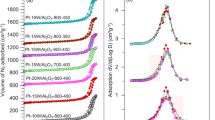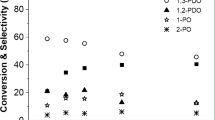Abstract
The platform chemical product 1,3-propanediol can be synthesized via the catalytic process starting from bioglycerol, the commercial by-product of biodiesel production, and the catalyst for this process is under development. In the present work, TG–DTA and TPR-H2 methods were applied to study the effect of preparation conditions on the properties of the most efficient 2%Pt/10%W/Al2O3 catalytic materials that were prepared by H2PtCl6 supporting on W-modified alumina, which was preliminarily synthesized from ammonium paratungstate and the high-surface (200–260 m2 g−1) boehmite. Thermal treatment of the intermediate W-modified boehmite resulted in the γ-Al2O3 support at 550 °C, yet the calcination temperature of 800 °C was required to avoid the W leaching during the next step of H2PtCl6 deposition and in the reaction. The intensive decomposition of supported Pt compounds proceeded up to 550 °C resulting in Pt0 nanoparticles and several Ptn+ species reducible in the range of 0–600 °C. The enhanced hydrogen consumption at 600–840 °C indicated a strong interaction between Pt0 nanoparticles and WOx species. The reducibility of the prepared materials depended on the boehmite origin, on the conditions of polytungstate deposition, and on the calcination temperature of the terminal material. The possible genesis of materials was discussed. The catalytic behavior of the materials in the reaction of glycerol hydrogenation was varied with the reducibility, and the most active materials exhibited the larger hydrogen uptake in the temperature range 60–300 °C.










Similar content being viewed by others
References
Nakagawa Y, Tamura M, Tomishige K. Perspective on catalyst development for glycerol reduction to C3 chemicals with molecular hydrogen. Res Chem Intermed. 2018;44:3879–903. https://doi.org/10.1007/s11164-018-3481-2.
Bagheri S, Julkapli NM, Yehye WA. Catalytic conversion of biodiesel derived raw glycerol to value added products. Renew Sustain Energy Rev. 2015;41:113–27. https://doi.org/10.1016/j.rser.2014.08.031.
Sun D, Yamada Y, Sato S, Ueda W. Glycerol hydrogenolysis into useful C3 chemicals. Appl Catal B Environ. 2016;193:75–92. https://doi.org/10.1016/j.apcatb.2016.04.013.
Wang J, Zhao X, Lei N, Li L, Zhang L, Xu S, Miao S, Pan X, Wang A, Zhang T. Hydrogenolysis of glycerol to 1,3-propanediol under low hydrogen pressure over WOx-supported single/pseudo-single atom Pt catalyst. ChemSusChem. 2016;9:784–90. https://doi.org/10.1002/cssc.201501506.
Arundhathi R, Mizugaki T, Mitsudome T, Jitsukawa K, Kaneda K. Highly selective hydrogenolysis of glycerol to 1,3-propanediol over a boehmite-supported platinum/tungsten catalyst. ChemSusChem. 2013;6:1345–7. https://doi.org/10.1002/cssc.201300196.
Dam J, Djanashvili K, Kapteijn F, Hanefeld U. Pt/Al2O3 catalyzed 1,3-propanediol formation from glycerol using tungsten additives. ChemCatChem. 2013;5:497–505. https://doi.org/10.1002/cctc.201200469.
Garcia-Fernandez S, Gandarias I, Requies J, Güemez MB, Bennici S, Auroux A, Arias PA. New approaches to the Pt/WOx/Al2O3 catalytic system behavior for the selective glycerol hydrogenolysis to 1,3-propanediol. J Catal. 2015;32:365–75. https://doi.org/10.1016/j.jcat.2014.12.028.
Garcia-Fernandez S, Gandarias I, Requies J, Arias PA, Weckhuysen BM. The role of tungsten oxide in the selective hydrogenolysis of glycerol to 1,3-propanediol over Pt/WOx/Al2O3. Appl Catal B Environ. 2017;204:260–72. https://doi.org/10.1016/j.apcatb.2016.11.016.
Zhu S, Gao X, Zhu Y, Li Y. Promoting effect of WOx on selective hydrogenolysis of glycerol to 1,3-propanediol over bifunctional Pt–WOx/Al2O3 catalysts. J Mol Catal A Chem. 2015;398:391–8. https://doi.org/10.1016/j.molcata.2014.12.021.
Liu L, Zhang Y, Wang A, Zhang T. Mesoporous WO3 supported Pt catalyst for hydrogenolysis of glycerol to 1,3-propanediol. Chin J Catal. 2012;33:1257–61. https://doi.org/10.1016/S1872-2067(11)60425-7.
Shi G, Xu J, Song Z, Cao Z, Jin K, Xu S, Yan X. Selective hydrogenolysis of glycerol to 1,3-propanediol over Pt–WOx/SAPO-34 catalysts. Mol Catal. 2018;45:622–30. https://doi.org/10.1016/j.mcat.2018.06.018.
Szilágyi IM, Sajó I, Király P, Tárkányi G, Tóth AL, Szabó A, Varga-Josepovits K, Madarász J, Pokol G. Phase transformations of ammonium tungsten bronzes. J Therm Anal Calorim. 2009;98:707–16. https://doi.org/10.1007/s10973-009-0287-x.
Hunyadi D, Sajó I, Szilágyi IM. Structure and thermal decomposition of ammonium metatungstate. J Therm Anal Calorim. 2014;116:329–37. https://doi.org/10.1007/s10973-013-3586-1.
Kalpakli AO, Arabaci A, Kahruman C, Yusufoglu I. Thermal decomposition of ammonium paratungstate hydrate in air and inert gas atmospheres. Int J Refract Met Hard Mater. 2013;37:106–16. https://doi.org/10.1016/j.ijrmhm.2012.11.004.
Fait MJG, Moukhina E, Feist M, Lunk H-J. Thermal decomposition of ammonium paratungstate tetrahydrate: new insights by a combined thermal and kinetic analysis. Thermochim Acta. 2016;637:38–50. https://doi.org/10.1016/j.tca.2016.05.009.
Jóźwiak WK, Maniecki TP. Influence of atmosphere kind on temperature programmed decomposition of noble metal chlorides. Thermochim Acta. 2005;435:151–61.
Radivojević D, Seshan K, Lefferts L. Preparation of well-dispersed Pt/SiO2 catalysts using low-temperature treatments. Appl Catal A Gen. 2006;301:51–8.
Lieske H, Lietz G, Spindler H, Völter J. Reactions of platinum in oxygen and hydrogen-treated Pt/γ-Al2O3 catalysts. 1. Temperature-programmed reduction, adsorption, and redispersion of platinum. J Catal. 1983;81:8–16.
Lietz G, Lieske H, Spindler H, Hanke W, Völter J. Reactions of platinum in oxygen and hydrogen-treated Pt/γ-Al2O3 catalysts. II. Ultraviolet–visible studies, sintering of platinum, and soluble platinum. J Catal. 1983;81:17–25.
Drożdż E, Łącz A, Spałek Z. Deposition of NiO on 3 mol% yttria-stabilized zirconia and Sr0.96Y0.04TiO3 materials by impregnation method. J Therm Anal Calorim. 2017;130:291–9. https://doi.org/10.1007/s10973-017-6406-1.
Kirichenko O, Kapustin G, Nissenbaum V, Strelkova A, Shuvalova E, Shesterkina A, Kustov L. Thermal decomposition and reducibility of silica-supported precursors of Cu, Fe and Cu–Fe nanoparticles. J Therm Anal Calorim. 2018;134:233–51. https://doi.org/10.1007/s10973-018-7122-1.
Jelić D, Zeljković S, Škundrić B, Mentus S. Thermogravimetric study of the reduction of CuO–WO3 oxide mixtures in the entire range of molar ratios. J Therm Anal Calorim. 2018;132:77–90. https://doi.org/10.1007/s10973-017-6921-0.
Garrido Pedrosa AM, Souza MJB, Melo DMA, Araujo AS. Thermo-programmed reduction study of Pt/WOx–ZrO2 materials by thermogravimetry. J Therm Anal Calorim. 2007;87(2):349–53. https://doi.org/10.1007/s10973-005-7432-y.
Garrido Pedrosa AM, Souza MJB, Lima SH, Melo DMA, Souza AG, Araújo AS. Influence of the synthesis method on the DTG–TPR profiles of Pt/WOx–ZrO2 bifunctional catalysts. J Therm Anal Calorim. 2007;87(3):703–7. https://doi.org/10.1007/s10973-006-7777-x.
Kirichenko OA, Kapustin GI, Nissenbaum VD, Mishin IV, Kustov LM. Evaluation of stability of silica-supported Fe–Pd and Fe–Pt nanoparticles in aerobic conditions using thermal analysis. J Therm Anal Calorim. 2014;118:749–58. https://doi.org/10.1007/s10973-014-3763-x.
Chukin GD, Seleznev YL. Mechanism of thermal decomposition of boehmite and model structure of alumina. Kinet Catal. 1989;30(1):69–77.
Boumaza A, Djelloul A, Guerrab F. Specific signatures of α-alumina powders prepared by calcination of boehmite or gibbsite. Powder Technol. 2010;201:177–80. https://doi.org/10.1016/j.powtec.2010.03.036.
Andryushkova OV, Kirichenko OA, Ushakov VA. Thermal stability of low-temperature alumina adsorbents and catalysts. Adsorption and its application in industry and environmental protection. Stud Surf Sci Catal. 1998;120:587–619.
Busca G. The surface of transitional aluminas: a critical review. Catal Today. 2014;226:2–13. https://doi.org/10.1016/j.cattod.2013.08.003.
Janampelli S, Darbha S. Selective and reusable Pt–WOx/Al2O3 catalyst for deoxygenation of fatty acids and their esters to diesel-range hydrocarbons. Catal Today. 2018;309:219–26. https://doi.org/10.1016/j.cattod.2017.06.030.
Baes CF, Mesmer JRE. The hydrolysis of cations. New York: Wiley; 1976. p. 257–60.
Strigul N. Does speciation matter for tungsten ecotoxicology? Ecotoxicol Environ Saf. 2010;73:1099–113. https://doi.org/10.1016/j.ecoenv.2010.05.005.
Hur H, Reeder RJ. Tungstate sorption mechanisms on boehmite: systematic uptake studies and X-ray absorption spectroscopy analysis. J Colloid Interfaces Sci. 2016;461:249–60. https://doi.org/10.1016/j.jcis.2015.09.011.
Raybaud P, Digne M, Iftimie R, Wellens W, Euzen P, Toulhoat H. Morphology and surface properties of boehmite (γ-AlOOH): a density functional theory study. J Catal. 2001;201:236–46.
Digne M, Sautet P, Raybaud P, Toulhoat H, Artacho E. Structure and stability of aluminum hydroxides: a theoretical study. J Phys Chem B. 2002;106:5155–62. https://doi.org/10.1021/jp014182a.
Zuo Z, Huang W, Han P, Gao Z, Li Z. Theoretical studies on the reaction mechanisms of AlOOH- and γ-Al2O3-catalysed methanol dehydration in the gas and liquid phases. Appl Catal A Gen. 2011;408:130–6. https://doi.org/10.1016/j.apcata.2011.09.011.
Wan C, Hu MY, Jaegers NR, Shi D, Wang H, Gao F, Qin Z, Wang Y, Hu JZ. Investigating the surface structure of γ-Al2O3 supported WOx catalysts by high field 27Al MAS NMR and electronic structure calculations. J Phys Chem C. 2016;120:23093–103. https://doi.org/10.1021/acs.jpcc.6b09060.
Shelimov B, Lambert J-F, Che M, Didillon B. Application of NMR to interfacial coordination chemistry: a 195Pt NMR study of the interaction of hexachloroplatinic acid aqueous solutions with alumina. J Am Chem Soc. 1999;121:545–56.
Delgado N, Yap D, Vivier L, Especel C. Influence of the nature of the support on the catalytic properties of Pt-based catalysts for hydrogenolysis of glycerol. J Mol Catal A. 2013;367:89–98. https://doi.org/10.1016/j.molcata.2012.11.001.
Acknowledgements
Electron microscopy characterization was performed in the Department of Structural Studies of Zelinsky Institute of Organic Chemistry, Moscow. The authors thank Prof. I.V. Mishin for the XRD analysis. The work was carried out with a financial support from Russian Science Foundation, Grant No. 17-73-20282.
Author information
Authors and Affiliations
Corresponding author
Additional information
Publisher's Note
Springer Nature remains neutral with regard to jurisdictional claims in published maps and institutional affiliations.
This paper belongs to the ESTAC12 Conference.
Rights and permissions
About this article
Cite this article
Kirichenko, O., Nissenbaum, V., Kapustin, G. et al. Thermal analysis of intermediates formed during preparation of a Pt/WOx/Al2O3 catalyst for 1,3-propanediol synthesis from glycerol. J Therm Anal Calorim 138, 2205–2218 (2019). https://doi.org/10.1007/s10973-019-08322-5
Received:
Accepted:
Published:
Issue Date:
DOI: https://doi.org/10.1007/s10973-019-08322-5




